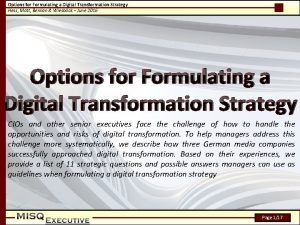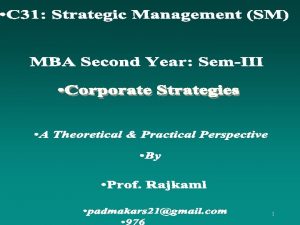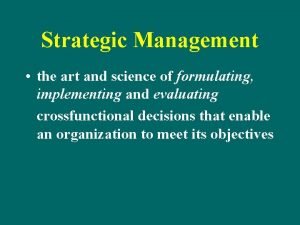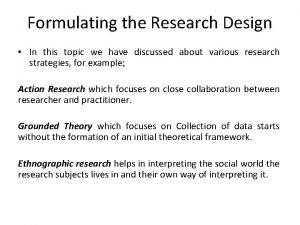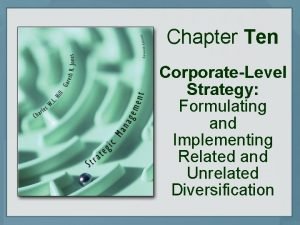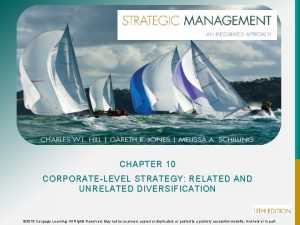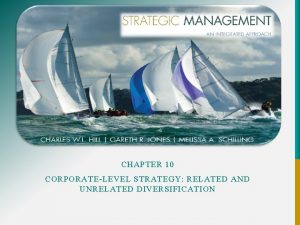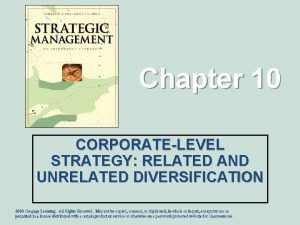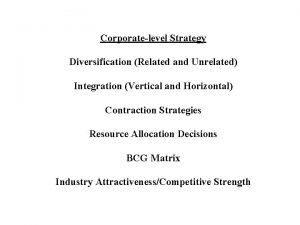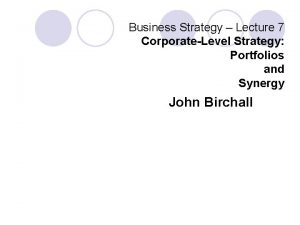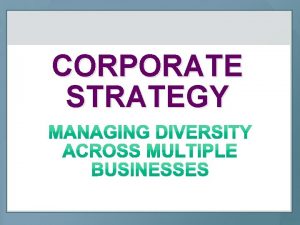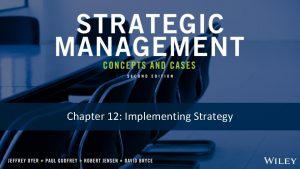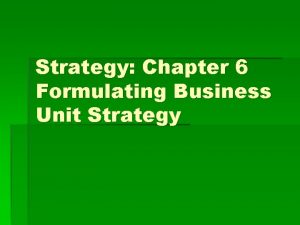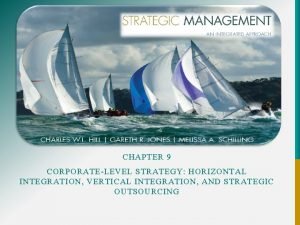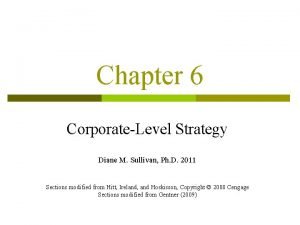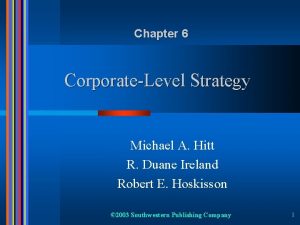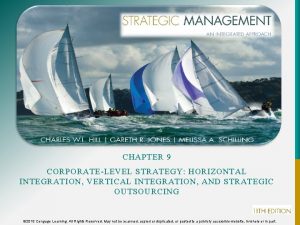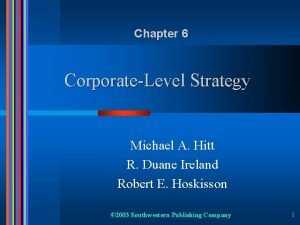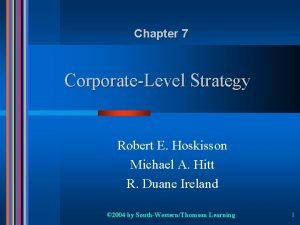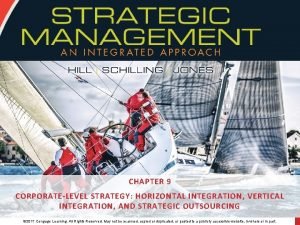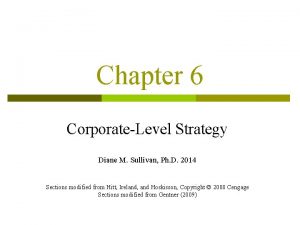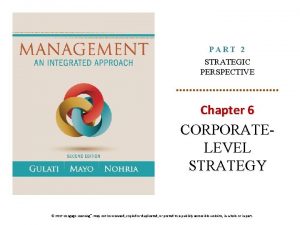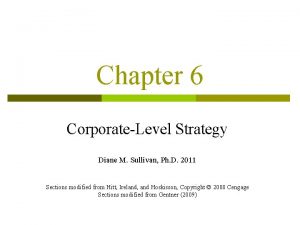Chapter 10 CorporateLevel Strategy Formulating and Implementing Related

































- Slides: 33

Chapter 10 Corporate-Level Strategy: Formulating and Implementing Related and Unrelated Diversification Copyright © Houghton Mifflin Company. All rights reserved. 10 - 1

Overview 1 Diversification – The process of adding new businesses to the company that are distinct from its established operations 2 Vehicles for diversification – Internal new venturing • Starting a new business from scratch – Acquisitions (formerly horizontal integration) – Joint ventures 3 Restructuring – Reducing the scope of diversified operations by exiting from business areas Copyright © Houghton Mifflin Company. All rights reserved. 10 - 2

Typical Evolution of Business • • • Single Product/Service Business Vertical Integration Horizontal Integration/Merger Related Diversification Unrelated Diversification Copyright © Houghton Mifflin Company. All rights reserved. 10 - 3

Expanding Beyond a Single Industry • Advantages of staying in a single industry – Focus resources and capabilities on competing successfully in one area – Focus on what the company knows and does best • Disadvantages of being in a single industry – Danger of the industry declining – Missing the opportunity to leverage resources and capabilities to other activities – Resting on laurels and not continually learning Copyright © Houghton Mifflin Company. All rights reserved. 10 - 4

A Brief History of Diversification • 1960 s and 70 s the trend was to diversify so as not to be too dependent on any single industry • 1980 s a general reversal of that thinking as “management found that they couldn’t manage the beast” M. Porter circa 1989 Copyright © Houghton Mifflin Company. All rights reserved. 10 - 8

Diversification: Three Types • Concentric: adding new but related products or services; commonalities between one or more components of each activity’s value chain. • Horizontal: adding new but unrelated products for current customers • Conglomerate: adding new, unrelated products or services; no obvious connection to any of a company’s value chain activities in its present industry or industries Copyright © Houghton Mifflin Company. All rights reserved. 10 - 9

Scopable Assets resources and capabilities that can be applied to new products and new geographic markets Copyright © Houghton Mifflin Company. All rights reserved. 10 - 10

Increasing Profitability Through Concentric Diversification • Transferring competencies – Taking a distinctive competence developed in one industry and applying it to an existing business in another industry – The competencies transferred must involve activities that are important for establishing competitive advantage Copyright © Houghton Mifflin Company. All rights reserved. 10 - 11

Copyright © Houghton Mifflin Company. All rights reserved. 10 - 12

St th u R y Bab Copyright © Houghton Mifflin Company. All rights reserved. ou f fe r’s 10 - 13

Philip Morris “We want to become the world’s largest provider of packaged consumer-products. ” * Biggest move was hostile takeover of Kraft General Foods, the world’s second largest food producer behind Nestle. * Hamish Maxwell, CEO Copyright © Houghton Mifflin Company. All rights reserved. 10 - 14

Transfer of Competencies at Philip Morris Copyright © Houghton Mifflin Company. All rights reserved. 10 - 15

Increasing Profitability Through Diversification (cont’d) • Leveraging competencies – Taking a distinctive competency developed by a business in one industry and using it to create a new business in a different industry • Sharing resources: economies of scope – Cost reductions associated with sharing resources across businesses Copyright © Houghton Mifflin Company. All rights reserved. 10 - 16

Sharing Resources at Procter & Gamble Copyright © Houghton Mifflin Company. All rights reserved. 10 - 17

Copyright © Houghton Mifflin Company. All rights reserved. 10 - 18

Increasing Profitability Through Diversification • Managing rivalry: multipoint competition – Diversifying into an industry in order to hold a competitor in check that has either entered its industry or has the potential to do so – Multipoint competition: companies competing against each other in different industries Disney vs. Viacom Copyright © Houghton Mifflin Company. All rights reserved. 10 - 19

Infoseek Copyright © Houghton Mifflin Company. All rights reserved. 10 - 20

Viacom Showtime S B C ter n Simo hus c S & s d n wi o r a C Copyright © Houghton Mifflin Company. All rights reserved. 10 - 21

AOL Time Warner Sport s e ap c s t ted a r t s u Ill V T urt Ne Co Compuserve s anta Atl ve a r B TNT Road Runner Time Magazine Hanna - Barbera Cartoons Copyright © Houghton Mifflin Company. All rights reserved. Fortune 10 - 22

Disney’s Latest Foray: Infoseek “Our products, our movies, sports and news all have to be delivered to the home and will be delivered via broadband lines from cable, TV, or satellite. We want to be in control of our destinations. We want to control our films, products, and entertainment. ”* * Michael Eisner Copyright © Houghton Mifflin Company. All rights reserved. 10 - 23

Horizontal Diversification • Walmart has attempted to acquire a bank (denied regulatory approval) and had planned to open 500 or so branches inside its stores Copyright © Houghton Mifflin Company. All rights reserved. 10 - 24

Horizontal Diversification Amazon is pursuing horizontal diversification with an aggressive entry into toys and consumer electronics Copyright © Houghton Mifflin Company. All rights reserved. 10 - 25

Increasing Profitability Through Unrelated Diversification • Exploiting general organizational competencies – Competencies that transcend individual functions or businesses and reside at the corporate level in the multibusiness enterprise – Entrepreneurial capabilities – Effective organization structure and controls – Superior strategic capabilities Copyright © Houghton Mifflin Company. All rights reserved. 10 - 26

Copyright © Houghton Mifflin Company. All rights reserved. 10 - 27

The Limits of Diversification • Related diversification is only marginally more profitable than unrelated diversification • Extensive diversification tends to depress rather than improve profitability Copyright © Houghton Mifflin Company. All rights reserved. 10 - 28

Bureaucratic Costs and Diversification Strategy • The costs increases that arise in large, complex organizations due to managerial inefficiencies • Number of businesses in a company’s portfolio – Information overload • Coordination among businesses – Inability to identify the unique profit contribution of a business unit that shares resources with another unit Copyright © Houghton Mifflin Company. All rights reserved. 10 - 29

Bureaucratic Costs and Diversification Strategy (cont’d) • Limits of diversification – Bureaucratic costs place a limit on the amount of diversification that can profitably be pursued • Related or unrelated diversification? – Related diversified companies can create value in more ways than unrelated companies, but they have to bear higher bureaucratic costs Copyright © Houghton Mifflin Company. All rights reserved. 10 - 31

Diversification That Dissipates Value • Diversifying to pool risks – Stockholders can diversify their own portfolios at lower costs than the company can – Research suggests that corporate diversification is not an effective way to pool risks • Diversifying to achieve greater growth – Growth on its own does not create value Copyright © Houghton Mifflin Company. All rights reserved. 10 - 32

Restructuring • Reducing the scope of the company by exiting business areas • Why restructure? – Diversification discount: investors see highly diversified companies as less attractive • Complexity and lack of transparency in financial statements • Too much diversification or for the wrong reasons – Response to failed acquisitions – Innovations have diminished the advantages of vertical integration or diversification Copyright © Houghton Mifflin Company. All rights reserved. 10 - 33

The Case of Allegis Corp. • April 30, 1987 UAL, Inc. changes its name to Allegis Corporation • Holding Company for Hertz Rental Car, Westin and Hilton Hotels, and United Airlines • June 9, 1987 Car rental executive Frank Olson is elected interim chairman, president - CEO of Allegis and chairman of United following departure of Richard Ferris. Edward Carlson rejoins Allegis board as a director and serves until May 26, 1988. Copyright © Houghton Mifflin Company. All rights reserved. 10 - 34

• Sept. 3, 1987 The Allegis board approves the sale of Hilton International • Oct. 29, 1987 Conniston Partners, a major Allegis investor group, forces Allegis to sell off its interests in The Hertz Corporation and Westin Hotels Company • May 26, 1988 Allegis name is dropped and the holding company is named UAL Corporation. Copyright © Houghton Mifflin Company. All rights reserved. 10 - 35

Restructuring Strategies • Exit strategies – Divestment • Spinoff • Selling to another company • Management buyout (MBO) – Harvest – Liquidation Copyright © Houghton Mifflin Company. All rights reserved. 10 - 36

In June 2005, Viacom announced a plan to separate into two focused and nimble companies, consisting of businesses with great assets and industry-leading brands. The separation was completed on December 31, 2005, by spinning off a new publicly traded company – called "Viacom Inc. " – that consists of the advertising-supported cable networks business, the Paramount Pictures business and Famous Music. The surviving company, which was formerly known as Viacom, changed its name upon the separation to "CBS Corporation. " Copyright © Houghton Mifflin Company. All rights reserved. 10 - 37
 Options for formulating a digital transformation strategy.
Options for formulating a digital transformation strategy. Formulating corporate level strategy
Formulating corporate level strategy Physical fitness two types
Physical fitness two types Health-related
Health-related What can be defined as the art and science of formulating
What can be defined as the art and science of formulating Formulating ideas
Formulating ideas Formulating and clarifying the research topic
Formulating and clarifying the research topic Formulating and clarifying the research topic
Formulating and clarifying the research topic Formulating and clarifying the research topic
Formulating and clarifying the research topic Formulating and clarifying the research topic
Formulating and clarifying the research topic Formulating and clarifying the research topic
Formulating and clarifying the research topic Formulating a thesis
Formulating a thesis Steps in formulating a community action plan
Steps in formulating a community action plan Intervening variable
Intervening variable Formulating a claim
Formulating a claim Research problem formulation
Research problem formulation Unit 1 materials formulating matter
Unit 1 materials formulating matter What is the objective of the imdg?
What is the objective of the imdg? Working thesis example
Working thesis example Research methodology chapter 4
Research methodology chapter 4 Formulating solutions
Formulating solutions Scope and delimitation example
Scope and delimitation example Management issues central to strategy implementation
Management issues central to strategy implementation Implementing strategies management and operations issues
Implementing strategies management and operations issues Implementing strategies: management and operations issues
Implementing strategies: management and operations issues Setting prices and implementing revenue management
Setting prices and implementing revenue management Designing and implementing brand architecture strategies
Designing and implementing brand architecture strategies Designing and implementing brand architecture strategies
Designing and implementing brand architecture strategies Crm project plan
Crm project plan Strategic business unit structure
Strategic business unit structure Flanker brand strategy
Flanker brand strategy Implementing strategies management and operations issues
Implementing strategies management and operations issues Corporate strategy and business strategy
Corporate strategy and business strategy Chase demand example
Chase demand example
